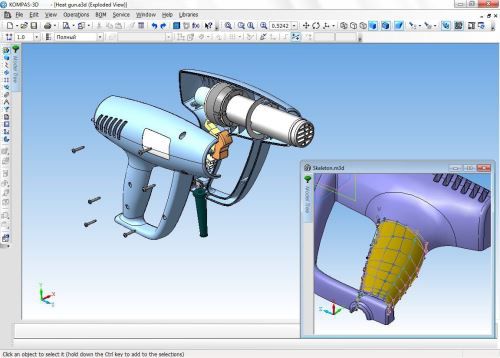
KOMPAS-3D is a flexible 3D modeling system that allows you to create models by several methods, including the following ones:
-
Bottom-up modeling using finished components.
-
Top-down modeling by designing components to match specific designs.
-
Modeling based on layout drawings, such as kinematic diagrams.
-
Or any combination of these modeling methods.
-
These approaches allow you to create editable associative models easily.
The KOMPAS-3D system has powerful functions for managing project of thousands of sub-assemblies, parts, and standard library products. It supports all the capabilities of 3D solids and surface modeling that have become the standard among medium-level CAD/CAM programs, including these ones:
-
Intuitive creation of new geometry, and importing and manipulation of surfaces.
-
Associative settings for element parameters.
-
Boolean operators for generating atypically shaped elements; functions include union, intersection, and subtraction.
-
Advanced surface and shape modeling for designing complex, ergonomic, and easy to use industrial products; functions include point grids, by network of curves, ruled surfaces, extrusions, lofted surfaces, swept surfaces, and revolutions.
-
Construction of auxiliary lines and planes, and spatial curves, including broken lines, splines, and spirals.
-
Addition of structural elements, such as chamfers, fillets, holes, stiffness elements, and thin-walled shells.
-
Creation of any shape of arrays and assembly components.
-
Component modeling with assemblies, with relative positioning of parts in assemblies.
-
Constraints for mating assembly components, including automatic constraints for faster assembly creation.
-
Special tools to simplify work with large assemblies.
-
Flexible parts and assembly editing, including characteristic points.
-
Redetermination of the parameters of any element at any design stage causes a reconstruction of the whole model.
-
Effective mould design with pattern drafts, joint lines, cavities defined by part shape, and shrinkage allowance.
-
Capable sheet metal modeling through sheet body creation, bends, holes, louver, fillets, punching (stamping) and cutting, cap closing, sheet metal unwrapping, and associative drawings of unwrapped sheet metal.
-
Inserting standards products into the model from a library, generating user model libraries.
-
Efficient collision detection of parts.
